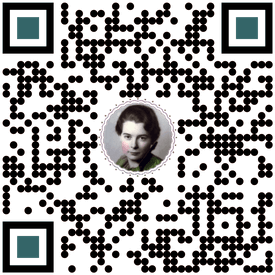Classic Vanilla Sponge Cake Recipe Step by Step
There's a special kind of magic in a truly classic vanilla sponge cake recipe, one that has been passed down through generations. Tucked away in my mother's treasured recipe scrapbook, with its faded ink and butter-stained pages from the 1920s, is this very recipe for a sponge cake that is genuinely as light as a cloud. In a world of dense, over-sweet desserts, this old-fashioned sponge cake is a delightful return to simplicity and elegance.
It's more than just a cake; it's a family heirloom that you can bake, filling your kitchen with the delicate aroma of vanilla and the warm nostalgia of a bygone era. Follow along, and I'll show you how to bring this piece of family history to life.
Enjoy the Taste of History
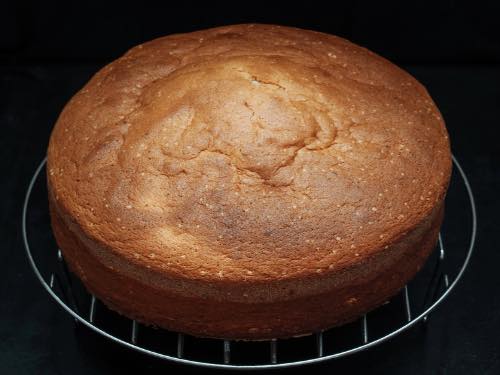 You Can Make This Classic Vanilla Sponge Cake from Scratch
You Can Make This Classic Vanilla Sponge Cake from Scratch(Source: ©Belkantus/Depositphotos.com)
This classic vanilla sponge cake recipe hails from a time when ingredients were simple and bakers relied on technique, not technology. In the 1920s, a light, airy sponge cake was a sign of a skilled home baker. It was the perfect canvas for seasonal fruits or a simple dollop of freshly whipped cream, making it a staple for Sunday dinners, church socials, and quiet afternoon teas.
This delicious cake isn't just about following steps, though you'll find the steps are easy to follow; it's about embracing a century-old tradition of creating something wonderful from the most basic pantry items.
Making It Your Own: Creative Variations
While this recipe is perfect as is, Grandma often added her own little touches depending on the occasion. Here are a few simple ways you can make this classic recipe your own:
- A Hint of Citrus: Add the finely grated zest of one lemon or half an orange to the egg yolk and sugar mixture for a bright, fresh flavor.
- Almond Essence: For a slightly richer, nutty aroma, substitute 1/2 teaspoon of almond extract for 1/2 teaspoon of the vanilla.
- A Jam-Filled Center: Once cooled, carefully slice the cake in half horizontally. Spread a thin layer of raspberry or strawberry jam on the bottom layer before placing the top layer back on.
How to Serve Your Classic Sponge Cake
The beauty of this old fashioned cake is its easy versatility. It can be dressed up or down with ease.
- The Simple Classic: A simple dusting of powdered sugar is all it needs to look elegant.
- Berries and Cream: Serve a slice with a spoonful of sweetened whipped cream and a handful of fresh berries.
- The Glazed Original: For that authentic, old-fashioned finish, use the simple sugar glaze recipe included below. It adds a delicate sweetness and a lovely, subtle sheen.
Master This Classic Vanilla Sponge Cake Recipe From Mom's Collection
Mom's Recipe Scrapbooks (1920s)
Ingredients for Your Perfect Sponge Cake
For a 9-inch cake, you'll need the following ingredients:
3/4 cup sugar
2 teaspoons vanilla
6 large eggs, separate the whites from the yolks
1 cup flour
2 tablespoons vegetable oil
2 tablespoons milk
- Let your oven preheat to 325°F as you gather the ingredients for this classic vanilla sponge cake recipe.
- The eggs need to be at room temperature.
- Grease and flour a 9-inch cake pan.
Step-by-Step Instructions for Light-as-Air Results
In a large bowl, use a whisk to mix the egg yolks with the sugar and vanilla, then set aside.
 Mix Your Sponge Cake Ingredients in a Large Bowl
Mix Your Sponge Cake Ingredients in a Large Bowl(Source: DIYplr)
In a medium mixing bowl, add the egg whites and beat until stiff peeks form. "Stiff peaks" means that when you beat the egg whites and lift the beaters out of the bowl, the peak that forms stands straight up without curling over. This is essential for the cake's sponge-like structure.
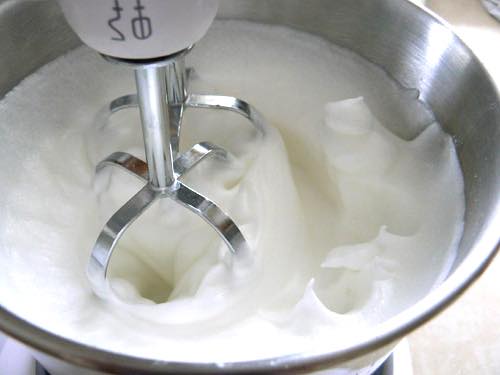 Beat the Egg Whites to Form Stiff Peaks
Beat the Egg Whites to Form Stiff Peaks(Source: DIYplr)
Fold half the beaten egg white mixture into the large bowl with all the egg yolks. Add the flour, oil, and milk, and mix gently until well combined.
Finally, fold in the remaining egg whites carefully, making sure the mixture stays as light and fluffy as possible. It's the trapped air in the batter that makes a sponge cake light and spongy in texture.
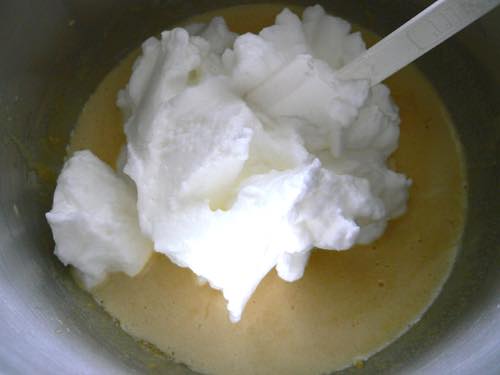 Fold Beaten Egg Whites into the Sponge Cake Batter
Fold Beaten Egg Whites into the Sponge Cake Batter(Source: DIYplr)
Pour the entire mixture into your greased cake pan, making sure that it's distributed evenly. Notice how light and airy the batter appears in the image below; that's what makes a sponge cake spongy.
Place the pan in your preheated oven and bake for about 25 to 30 minutes at 325°F.
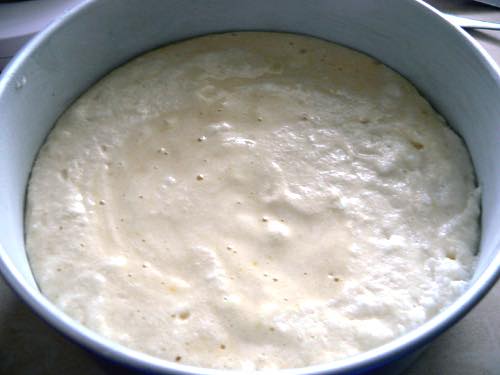 Pour the Sponge Cake Batter in the Cake Pan
Pour the Sponge Cake Batter in the Cake Pan(Source: DIYplr)
Around the 25 minute mark, test the cake to see whether it's baked, or whether it needs more time. The top of the cake should appear light brown, and the cake should spring back if you push your fingertips gently in the middle.
You can also insert a toothpick in the middle to ensure it comes out clean. Remove the cake from the oven once it's ready.
Run a table knife around the edge of the cake pan to separate the cake from the sides of the pan, and let it sit for about 15 minutes.
The cake will shrink slightly as it cools, and this will allow it to shrink evenly, instead of being stuck to the sides of the pan.
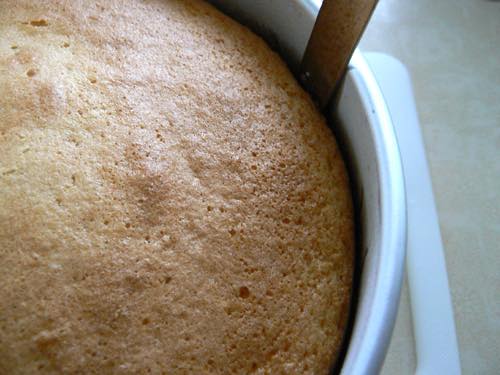 Separating the Baked Sponge Cake from the Cake Pan
Separating the Baked Sponge Cake from the Cake Pan(Source: DIYplr)
After 15 minutes, remove your cake from the pan by placing a cooling rack on top of the cake, then flipping over both rack and cake together, while gently tapping the pan to release the cake. You may need to loosen the cake further with a knife along its edges.
Once the cake has thoroughly cooled, it can be served plain, iced with sweetened whipped cream, or frosted. Or, you can brush on an old fashioned sugar glaze using the following recipe.
Simple Sugar Glaze Recipe
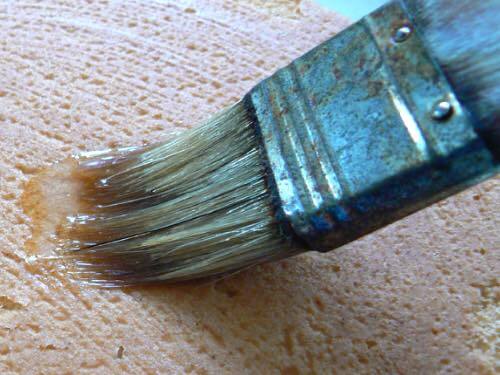 Brushing the Sugar Glaze on the Sponge Cake
Brushing the Sugar Glaze on the Sponge Cake(Source: DIYplr)
Simple ingredients you'll need to make a simple sugar glaze:
1 tablespoon water
1 tablespoon sugar
Place the water and sugar into a small saucepan. Heat while stirring until the sugar completely dissolves, then set aside.
Once the sponge cake has completely cooled, use a pastry brush to spread the sugar mixture over the entire surface of the cake.
Feel free to modify this classic vanilla sponge cake recipe by adding some of your favorite fruit to the batter or by replacing the glaze with your favorite topping.
Grandma Answers Your Questions
Classic sponge cakes are very versatile and by knowing how to make one, you can always have a delicious dessert handy whenever you need or want one.
Why Did My Cake Fall?
Why Did My Cake Fall?
The most common culprits are opening the oven door too early (don't peek before 25 minutes!) or over-mixing the batter after the egg whites are added, which deflates the precious air you worked so hard to incorporate.
Why Is My Sponge Cake Tough?
Why Is My Sponge Cake Tough?
A tough or rubbery sponge cake is usually the result of over-mixing the flour. Once the flour is added, mix only until it's just combined. A few small lumps are okay.
Why Fold the Beaten Egg?
Why Fold the Beaten Egg?
"Folding" is a gentle technique used to combine light, airy ingredients (like beaten egg whites) with a heavier batter. Use a spatula to cut down through the middle of the batter, scrape along the bottom of the bowl, and bring some of the bottom batter up and over the top.
Give the bowl a quarter turn and repeat until just combined. This preserves the air in the egg whites, which is the secret to a light-as-a-feather cake.
Why Are Eggs at Room Temperature?
Why Are Eggs at Room Temperature?
Using room temperature eggs is non-negotiable for a good sponge cake. Cold eggs don't whip up with as much volume, which will result in a denser cake. To warm them quickly, place whole eggs in a bowl of warm (not hot) water for 5-10 minutes.

Sign Up now for GRANDMA'S DESSERT CLUB and download your FREE PDF COPY of Grandma McIlmoyle's Little Dessert Book. Also receive my regular Bulletin featuring classic recipes and nostalgia.




